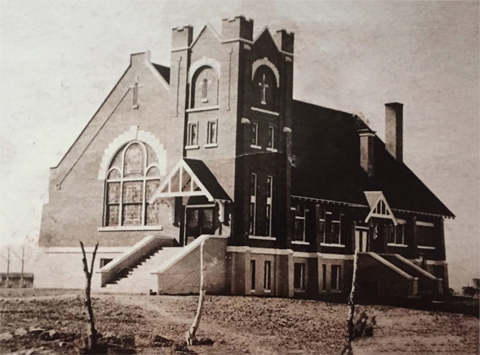(Photo of lady standing and gentleman sitting. Heading for the paragraph says, Charles E. Bolingbroke)
Pioneers of Arbon Valley, Power County, about 1895 were Charles E. and Margaret (Maggie) Bolingbroke. Charles was born in Savannah, Missouri, 11 January 1853, as his parents were crossing the plains with Mormon pioneers from England. Margaret was born in North Wales on 11 August 1857 and came to the United States at the age of 8 with her parents, Edward and Elizabeth Roberts. It took them 6 weeks to cross the ocean in a sailing vessel. During their journey across the plains, Margaret got to ride in the wagon while her sister Jane walked all the way and pushed the hand cart. Mr. Dalton was the team master of their wagon train. Their parents settled in Malad, Idaho, where Charles and Margaret grew up and later married, on the 8th of September 1876.
Following their marriage, Mr. and Mrs. Bolingbroke lived in Malad. Just before the turn of the century, they with other families from Malad homesteaded in Arbon Valley, which included Tom and Sarah Daniels, Donham and Martha Daniels, Dave and Catherine Daniels, John Lusk and family. (Dave Lusk’s Grandfather.)
Charles took their homestead on Bannock Creek in the north end of the valley. There they farmed and raised some livestock, chickens and pigs. They cured their meat and buried it in the wheat bin. A fat cow could be bought for $30.00. (Quite a difference from today’s price.) A log church house was built, called Meadow Ward, where they attended church in a white top buggy. A short distance from the church was a country store operated by Ed England.
In the late 1890’s and early 1900’s. Maggie (as they called her) made cheese for the community. She also made butter using a mold and paddle Charles made. Selling it for ten cents a pound. Charles was called the cheese man.
Maggie had a homemade cheese press that her husband made for her. They set 100 pounds of milk in a clean wash tub to sour. The milk was set on the stove until lukewarm, a rennet tablet and color tablet were put in. After the sour milk was ready the whey was drained off.
A hoop with a cloth on its bottom was made to hold the cursed cheese that was poured on it. A round board was fashioned to fit in the hoop (to press the whey out). The weight of the board did this with pressure from a screw jack.
The cheese was made into a round or a square, weighing ten pounds. The cheese was set on shelves inside the house and were turned and rubbed with butter to keep from molding, every day for ten days. After ten days they were ready to eat or sell for ten cents a pound. She always had some cheese aging in the cellar.
In the summer the boys helped their Father on the farm. Every fall they went to school at Pauline for a while, then moved to Malad for the winter and returned early in the spring. Although the winters were very severe, they would put hay in their sleigh and take lots of blankets and hot rocks to keep warm and go visit their neighbors. Also for entertainment they had many neighborhood parties during the summer and dances at the church or school house every Saturday night, and horseback riding. They also had ball games every week. John Noble was manager of the team. Some of the players were: Alfred Bolingbroke, Park Lusk, Featherton, Dale Butler, Dave Lusk Sr., and Fisher.
Charlie and Maggie were neighborly people, having friends throughout the valley. They were always friendly and generous with the Indians and sold cheese to them. One old Indian (Dave Dover) would come every Sunday for his dinner.
(photo of Maggie standing, Charles sitting and their little daughter, Mae standing. Heading says, Charles and Maggie Bolingbroke, Girl is Mae Jones.)
Many people freighting grain from the south end of the valley spent the night at their place as well as other travelers through the valley. Young people were always welcome and congregated there a great deal.
It would take 2 or 3 days traveling in a wagon to take their commodities to trade for supplies. On one of their trips to Pocatello their team balked and they had to borrow a team from the Indains to finish their trip.
(Photo of a group of women. Heading says, Group of women and men, taken at Maggie’s 81st. Birthday celebration. Another photo of a group of men below the previous heading.)
They had a family of 10 children, 2 of whom died while very young. Thomas John and Leo. Their daughter May, was married to George Daniels of Malad, Louise married John D. Jones of Malad, Elizabeth married Joseph Munn of Pocatello, Minnie married Richard F. Steed of Pocatello, Claribel married Lorin H. Bailey of Wellsville, Utah, now of Pocatello, Guy married Hazel Stone of Malad, now of Pocatello, Edward and Alfred of Arbon stayed on the ranch, Edward went to college in Pocatello, Idaho. He was very good in Mathematics and solved any math problems they gave him. Alfred was a baseball fan and was the catcher on the baseball team for many years. He also loved to fish. He was the Arbon Valley Barber for many years. Neither Edward or Alfred married. Also, Mr. and Mrs. Bolingbroke reared a grandson, LaVern Munn, following his mother’s death shortly after he was born. LaVern married Carolyn Schneider of Minidoka.
Charles was injured in a fall from a horse and was unable to walk for a number of years. He was very proud and refused to use a wheelchair. He died in Arbon Valley June 22, 1924.
Maggie continued to live on the farm; she died at the age of 85, January, 1943 at Pocatello, Idaho.
Written by Guy and Hazel Bolingbroke and Carolyn Munn
